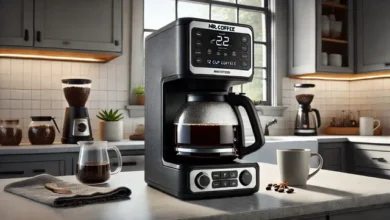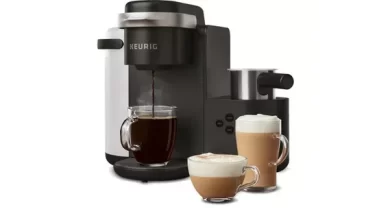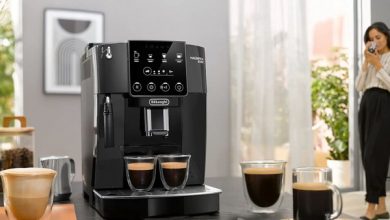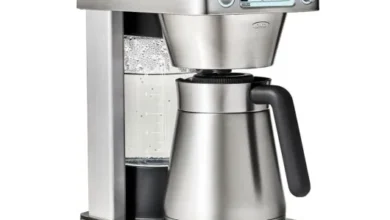For many coffee lovers, the perfect cup of espresso is more than just a morning routine—it’s an art form. The balance of bold flavor, rich crema, and velvety texture is something that espresso enthusiasts strive to recreate at home. But achieving café-quality espresso in your kitchen requires the right tools, and that’s where the KitchenAid espresso maker comes in.
Known for their durable, beautifully designed kitchen appliances, KitchenAid has earned a reputation for producing high-quality products that combine functionality with style. Their line of espresso machines is no exception. Whether you’re an espresso aficionado who enjoys mastering every step of the brewing process or simply someone who loves a great cup of coffee without the fuss, KitchenAid offers a range of machines designed to meet your needs.
This guide will dive deep into what makes the KitchenAid espresso maker special, how to use it for the perfect cup, and whether it’s the right investment for your home coffee setup. From its features and cleaning tips to comparisons with competitors like Breville, we’ll explore everything you need to know about this espresso maker. So, if you’re ready to elevate your coffee game, read on to discover whether the KitchenAid espresso maker is the perfect fit for you.
What Is the KitchenAid Espresso Maker?
When it comes to household appliances, the KitchenAid brand is synonymous with durability, style, and performance. Known for its iconic stand mixers and versatile kitchen gadgets, KitchenAid has ventured into the world of coffee machines with its line of espresso makers. But what exactly is the KitchenAid espresso maker, and how does it stand out in a market crowded with options?
At its core, the KitchenAid espresso maker is designed to bring the luxury of café-quality espresso to the home. These machines are crafted with both coffee connoisseurs and casual drinkers in mind, offering a combination of simplicity, precision, and consistent results. Whether you’re new to making espresso or a seasoned enthusiast, KitchenAid provides an espresso maker that meets your needs.
KitchenAid offers a few different models of espresso machines, with varying features depending on your preferences and budget. Typically, these machines fall into two main categories: manual espresso makers and automatic espresso machines. Manual machines provide more control over the brewing process, allowing the user to fine-tune the water temperature, pressure, and grind size, making them ideal for espresso purists. On the other hand, automatic models are geared towards convenience, providing one-touch operations that take the guesswork out of the process—perfect for those who want their espresso fast without sacrificing quality.
One of the standout models is the KitchenAid Semi-Automatic Espresso Machine. It boasts a sleek, stainless steel design that not only looks great on any countertop but is also built to last. This model is ideal for people who want more involvement in the espresso-making process but still appreciate a bit of automation. It gives users the ability to adjust water temperature and steam pressure, which are critical factors in achieving the perfect espresso shot. For those who are just beginning to explore the world of espresso, this machine provides the flexibility to experiment while still being user-friendly.
The KitchenAid Precision Press Coffee Maker, while not exclusively an espresso machine, is another option for coffee lovers. This model focuses on providing a richer coffee experience through a French press system. It’s an excellent choice for those who enjoy espresso-style coffee but prefer the fuller-bodied taste that a French press offers.
Overall, the KitchenAid espresso maker lineup is distinguished by its ease of use, thoughtful design, and high-quality construction. Unlike other espresso machines on the market that can be overly complex or poorly built, KitchenAid strikes a balance between offering professional-grade features and maintaining accessibility for the average home user. Whether you’re pulling a quick shot before heading to work or savoring an afternoon latte, KitchenAid ensures you can craft delicious espresso beverages from the comfort of your kitchen.
How to Use the KitchenAid Espresso Maker for Perfect Coffee
Now that you understand what makes the KitchenAid espresso maker so special, let’s dive into how to use one to brew that perfect espresso. The process of making espresso might seem daunting to a beginner, but once you break it down into simple steps, it becomes an enjoyable routine that yields rewarding results.
Step-by-Step Guide for Brewing with the KitchenAid Espresso Maker
- Preheat the Machine
- The first step in any espresso-making process is ensuring that your machine is properly preheated. KitchenAid espresso machines, like many others, have a built-in heating element that brings the water to the optimal brewing temperature. Preheating is crucial because water that’s too cold will result in under-extracted coffee, leaving you with a weak and sour taste. On the flip side, too hot, and your espresso will taste burnt. The ideal temperature is around 195 to 205 degrees Fahrenheit.
- Grind Your Coffee Beans
- Freshly ground coffee beans make all the difference. Invest in a good quality burr grinder to achieve a consistent grind size. For espresso, you want a fine grind—similar to table salt. KitchenAid even offers grinders designed to pair with their espresso machines. Grinding your coffee just before brewing ensures maximum freshness and flavor.
- Tamp the Coffee Grounds
- Once your coffee is ground, it’s time to tamp. Tamping compresses the coffee grounds evenly in the portafilter, creating the right resistance for water to pass through. This step is critical; uneven tamping can lead to uneven extraction, resulting in weak or overly bitter espresso. Use a tamper to press down firmly with even pressure, but avoid tamping too hard, which could block the water flow entirely.
- Attach the Portafilter and Start Brewing
- After tamping, place the portafilter into the machine’s group head and secure it. At this point, the KitchenAid espresso machine takes over most of the work. Simply press the brew button, and the machine will pump water through the coffee grounds at the right pressure—ideally between 9 and 15 bars—to extract the rich, flavorful espresso.
- Froth Milk (Optional)
- If you’re making a milk-based drink like a latte or cappuccino, the next step is frothing the milk. KitchenAid machines come with a steam wand that allows you to froth milk to the perfect texture. Hold your milk pitcher under the steam wand and submerge the tip just below the surface of the milk. As you froth, the milk will expand, creating a creamy, velvety texture ideal for lattes and cappuccinos.
- Serve and Enjoy
- Once your espresso is brewed and your milk is frothed, it’s time to enjoy! Pour your shot into a cup and add the frothed milk if desired. For an extra treat, try experimenting with flavored syrups, or top your drink with a sprinkle of cocoa or cinnamon.
Tips for Making the Perfect Espresso
- Use Fresh Beans: Always use freshly roasted coffee beans. Coffee begins to lose its flavor after being ground, so grinding your beans right before brewing is essential for a rich taste.
- Pay Attention to Water Quality: The quality of water you use can significantly affect the taste of your espresso. Use filtered water for the best results.
- Clean Regularly: Clean your machine after each use to ensure there’s no buildup of coffee oils or grounds, which can impact both the flavor and performance of your machine over time.
- Experiment: Don’t be afraid to adjust variables like grind size, tamp pressure, and water temperature. Espresso-making is part art, part science—small adjustments can lead to better results.
With a bit of practice and the right tools, using a KitchenAid espresso maker becomes a satisfying routine that delivers café-quality espresso every time.
KitchenAid Espresso Maker Features Explained
When considering an espresso machine, understanding its key features is essential in determining whether it’s the right fit for your home. KitchenAid espresso makers are built with a range of features that make them stand out in the crowded marketplace of coffee machines. From design to functionality, these machines offer several notable elements that contribute to a high-quality espresso experience.
- Stainless Steel Body
One of the first things that users notice about KitchenAid espresso makers is their robust, sleek design. These machines are built with stainless steel bodies, which not only enhance the aesthetic appeal but also improve durability. The solid construction ensures that the machine will last for years, even with regular use. Unlike plastic-bodied machines, which are prone to wear and tear over time, the stainless steel structure of a KitchenAid espresso maker provides longevity and a professional-grade feel.
- Dual Boiler System
Many KitchenAid espresso machines come equipped with a dual boiler system, which is a standout feature for espresso enthusiasts. This system allows for simultaneous brewing of espresso and steaming of milk, meaning you don’t have to wait between pulling your shot and frothing your milk. In machines without a dual boiler, you often need to wait for the water to reach the proper temperature for frothing after brewing your espresso, which can be time-consuming.
The dual boiler also ensures that both the espresso shot and the milk foam are prepared at the ideal temperatures. This results in a smoother, richer coffee experience, as neither component is compromised by temperature fluctuations. Whether you’re preparing a simple espresso shot or a more complex latte or cappuccino, the dual boiler system is a major convenience and enhances the overall quality of your coffee.
- Adjustable Temperature Control
Another key feature in KitchenAid espresso makers is the ability to adjust the water temperature. This level of control is critical for those who want to fine-tune their coffee-making process. Different types of coffee beans may require slightly different brewing temperatures to bring out their best flavors. For example, lighter roasts may benefit from a slightly higher temperature to extract more complex flavors, while darker roasts might need cooler water to avoid bitterness.
KitchenAid machines typically offer easy-to-use controls that allow you to make these adjustments with precision, giving you complete control over the brewing process. This flexibility is especially valuable for people who want to experiment with different types of beans and brewing techniques.
- Built-In Milk Frother
For fans of lattes, cappuccinos, or macchiatos, the built-in milk frother is a game-changer. KitchenAid espresso machines are equipped with a steam wand or frothing arm that lets you froth milk to your desired consistency. Whether you prefer a silky, microfoam texture for a flat white or thicker froth for a cappuccino, the frother allows for easy customization.
The frother is powerful and quick, making it ideal for creating the perfect foam every time. It’s also a versatile tool—you can use it to heat milk without frothing for a creamy latte or to create other milk-based beverages like hot chocolate.
- 15-Bar Pressure Pump
Another essential feature of the KitchenAid espresso maker is its 15-bar pressure pump. This pump ensures the water is pushed through the coffee grounds at the optimal pressure for extracting rich, full-bodied espresso. In commercial espresso machines, pressure is a key factor in achieving the right crema, the golden layer of foam that tops a well-pulled shot of espresso.
Many cheaper espresso machines use lower pressure, which often results in weak or under-extracted coffee. The 15-bar pressure in KitchenAid models ensures that you consistently get high-quality espresso, with the full spectrum of flavors extracted from your coffee grounds.
KitchenAid Espresso Maker vs. Breville: Which Is Better?
When comparing espresso machines, two major players often come up: KitchenAid and Breville. Both brands have a reputation for producing high-quality home appliances, and both offer a range of espresso machines designed for home use. So, how do these two brands stack up against each other?
- Design and Build Quality
Both KitchenAid and Breville excel in terms of design and build quality. KitchenAid is known for its sturdy, industrial-style machines that use a lot of stainless steel, giving them a more durable and robust feel. On the other hand, Breville machines are often sleeker, with a more modern look. While both brands use high-quality materials, Breville machines tend to be lighter and more compact, making them ideal for smaller kitchens.
In terms of build, KitchenAid machines may have a slight edge when it comes to durability, thanks to their solid construction. Breville, however, offers more models with brushed metal finishes, which gives them a stylish, contemporary aesthetic.
- Ease of Use
When it comes to ease of use, both brands are relatively user-friendly, though KitchenAid machines tend to be slightly more beginner-oriented. The KitchenAid models, especially the semi-automatic ones, are designed with straightforward controls and fewer technical complexities. This makes them a great option for those new to making espresso at home.
Breville machines, on the other hand, often come with more advanced settings and customization options. While this can be a benefit for experienced users looking to fine-tune every aspect of their espresso, it might feel overwhelming for beginners.
- Brewing Performance
Brewing performance is where both brands truly shine, but they do so in different ways. KitchenAid’s dual boiler system and 15-bar pressure pump offer excellent consistency and reliability in terms of temperature control and espresso extraction. Breville machines, such as the Breville Barista Express, often come with additional features like built-in grinders and customizable shot volumes, giving users more control over their brewing process.
If you’re looking for an all-in-one machine that includes a grinder and more sophisticated settings, Breville might be the better choice. However, if you prefer a simpler, high-quality machine that’s easy to use and built to last, KitchenAid is hard to beat.
- Price
Price is another factor where these two brands differ. KitchenAid espresso machines are often priced at the higher end of the market, reflecting their build quality and premium features. Breville offers a wider range of price points, with entry-level models that are more affordable for those just getting started with home espresso making.
Best KitchenAid Espresso Maker Accessories
Owning an espresso machine is just the beginning of your home coffee journey. To get the most out of your KitchenAid espresso maker, you’ll want to consider investing in some additional accessories. These can improve both the quality of your coffee and the convenience of your brewing process.
- Burr Coffee Grinder
A burr grinder is essential for anyone serious about making espresso. Unlike blade grinders, which chop the coffee beans unevenly, burr grinders create uniform grounds, which is crucial for consistent espresso extraction. KitchenAid offers a range of burr grinders that pair perfectly with their espresso machines.
- Tamper
A tamper is a must-have tool for packing the coffee grounds evenly in the portafilter. Some KitchenAid machines come with a basic tamper, but you may want to invest in a higher-quality, weighted tamper for better results. Proper tamping ensures that the water flows evenly through the coffee grounds, resulting in a balanced and rich shot of espresso.
- Milk Frothing Pitcher
For those who love milk-based espresso drinks, a milk frothing pitcher is another useful accessory. It allows you to froth and pour milk with greater control, especially when creating latte art. Stainless steel pitchers are the best choice because they conduct heat well and are easy to clean.
- Knock Box
A knock box is a small container that allows you to dispose of used coffee grounds quickly and efficiently. Instead of going to the trash or sink, you can simply tap the portafilter against the knock box to release the used puck. It’s a small investment that can make your espresso routine much cleaner and more convenient.
With the right accessories, you can truly elevate your espresso-making experience and get the most out of your KitchenAid espresso maker. Whether it’s grinding your coffee to perfection, achieving the perfect tamp, or frothing milk like a barista, these tools make a noticeable difference in your coffee-making routine.
KitchenAid Espresso Maker Cleaning and Maintenance Tips
One of the keys to ensuring that your KitchenAid espresso maker continues to produce delicious, high-quality espresso is proper cleaning and maintenance. Espresso machines, like any kitchen appliance, require regular upkeep to function optimally and to maintain the flavor integrity of your coffee. Below are essential tips on how to clean and maintain your KitchenAid espresso maker.
- Daily Cleaning Routine
After each use, there are a few simple steps you should follow to keep your machine clean and ready for the next cup.
- Wipe down the steam wand: After frothing milk, it’s crucial to clean the steam wand immediately. Use a damp cloth to wipe it down and run steam through it for a few seconds to clear out any milk residue. This prevents milk from drying and clogging the wand, which can affect the frothing process.
- Rinse the portafilter and filter basket: Once you’ve pulled your shot of espresso, knock out the used coffee grounds and rinse the portafilter and filter basket under hot water. This helps remove any remaining coffee oils and particles that could lead to bitterness in your next shot.
- Empty and clean the drip tray: The drip tray collects excess water and coffee residue during the brewing process. Make sure to empty and rinse it daily to prevent build-up and odors.
- Weekly Cleaning Routine
In addition to daily upkeep, your KitchenAid espresso maker requires a more thorough cleaning on a weekly basis.
- Backflushing the machine: Backflushing is a process where water (or a cleaning solution) is forced through the machine’s brew group in reverse. This helps remove oils and debris that have accumulated inside the machine. Many KitchenAid espresso machines come with a blank filter basket for this purpose. You can perform this process with a cleaning solution specifically designed for espresso machines to ensure optimal cleanliness.
- Descale the machine: Hard water can lead to limescale build-up inside the machine, particularly in the water reservoir and boiler. Descaling removes this build-up and keeps the machine running smoothly. KitchenAid offers descaling solutions that are safe for use with their machines. It’s recommended to descale your machine every few months, depending on the hardness of your water.
- Clean the group head: Over time, coffee grounds and oils can accumulate around the group head, affecting the quality of your espresso. Use a soft brush to clean around the group head and remove any debris.
- Deep Cleaning
Every few months, it’s a good idea to give your KitchenAid espresso maker a deep cleaning to ensure it continues to function like new.
- Disassemble and clean parts: Take apart removable parts such as the portafilter, steam wand tip, and filter baskets. Soak them in warm, soapy water and use a brush to scrub away any coffee residues. This deep cleaning ensures that no old coffee oils or milk solids are lingering on the machine’s parts, which could affect the flavor of your espresso.
- Check and replace gaskets: The rubber gaskets around the portafilter and other seals can wear out over time. Inspect them for signs of wear and replace them as necessary to maintain a proper seal and prevent leaks during brewing.
By following these cleaning and maintenance tips, your KitchenAid espresso maker will remain in top working condition for years to come, and you’ll continue to enjoy consistently delicious espresso.
KitchenAid Espresso Maker Price: Is It Worth It?
Investing in a high-quality espresso machine is a significant decision, and for many, the question arises: Is the KitchenAid espresso maker worth its price? Let’s take a closer look at the value proposition to help you decide if this machine is the right fit for your home.
- Build Quality and Durability
One of the key reasons KitchenAid espresso makers tend to be priced on the higher end of the market is their build quality. As mentioned earlier, these machines are constructed with stainless steel, ensuring they are durable and built to last. While there are certainly cheaper espresso machines on the market, they often use lower-quality materials like plastic, which may wear down over time. If longevity and sturdiness are important to you, the KitchenAid espresso maker is a worthwhile investment.
- Features vs. Price
Another important consideration when assessing whether the price is worth it is the range of features that KitchenAid espresso makers offer. From the dual boiler system to the 15-bar pressure pump and adjustable temperature controls, these machines come equipped with features that rival commercial espresso machines. For espresso enthusiasts who appreciate having more control over the brewing process, these features make a significant difference in the quality of the coffee.
Additionally, the inclusion of a built-in milk frother and other advanced functionalities means you’re not just paying for an espresso machine—you’re getting a versatile coffee-making system. If you regularly visit cafés for your daily espresso or lattes, investing in a KitchenAid machine could save you money in the long run by allowing you to make your favorite drinks at home.
- Customer Reviews and Feedback
Customer feedback is another important factor in determining whether a product is worth its price. KitchenAid espresso makers generally receive high marks from users for their ease of use, reliability, and consistent performance. Many reviews praise the machines for their ability to produce café-quality espresso and for their stylish, durable design.
While the initial price tag might be higher than some other home espresso machines, many users find that the quality of the coffee and the machine’s longevity justify the cost. The general consensus is that if you’re serious about making high-quality espresso at home, a KitchenAid espresso maker is a worthwhile investment.
- Where to Buy
KitchenAid espresso makers are widely available both online and in stores. Popular retailers include Amazon, Bed Bath & Beyond, and directly through the KitchenAid website. Prices may vary depending on the retailer and any ongoing promotions or discounts. It’s a good idea to keep an eye out for sales, especially around major shopping holidays like Black Friday, when you may be able to snag a KitchenAid espresso maker at a reduced price.
Conclusion: Is the KitchenAid Espresso Maker Right for You?
In conclusion, the KitchenAid espresso maker offers a combination of durability, style, and performance that makes it a strong contender in the home espresso machine market. Whether you’re a coffee enthusiast who enjoys fine-tuning every aspect of the espresso-making process or a casual drinker looking for convenience, KitchenAid has a machine that can meet your needs.
With its robust build quality, advanced features like the dual boiler system, and a powerful 15-bar pressure pump, the KitchenAid espresso maker delivers café-quality espresso from the comfort of your home. While the initial investment may be higher than some other brands, the long-term value in terms of quality, performance, and durability makes it a sound choice for anyone serious about their coffee.
If you prioritize ease of use, longevity, and the ability to make a wide range of espresso-based beverages at home, the KitchenAid espresso maker is certainly worth considering. Whether you’re pulling your first shot or you’ve been making espresso for years, this machine will help you achieve consistently great results, day after day.








